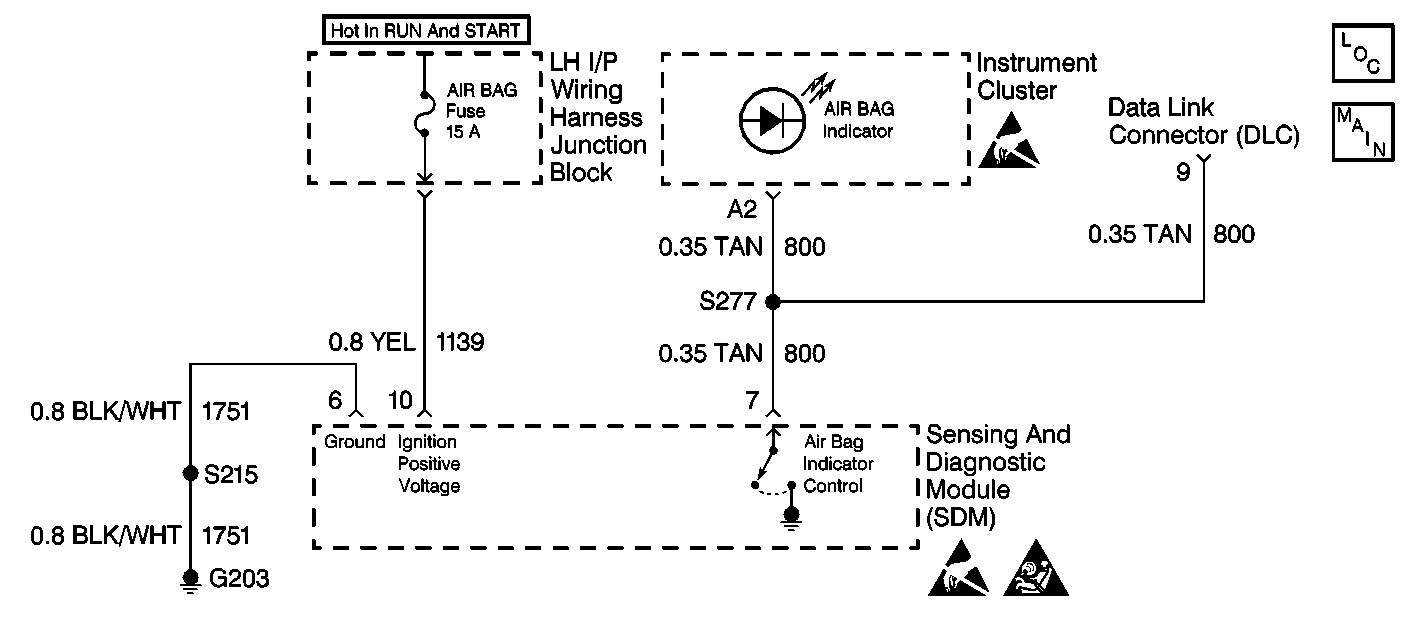
Circuit Description
When the ignition switch is first turned to OFF/UNLOCK or RUN, IGNITION 1 voltage is applied from the CLS/PCM fuse to the Indicators bus in the IPC. The ground side of the AIR BAG indicator (LED) is controlled by the instrument cluster microprocessor. When the ignition switch is in the OFF/UNLOCK position, the serial data line (CKT 800) is not operative. This condition will cause the IPC microprocessor to turn the AIR BAG (as well as the SEAT BELT) indicator ON steady. When the ignition switch is first turned to RUN, the AIR BAG fuse applies battery voltage to the IGNITION 1 input, terminal 10. The inflatable restraint Sensing and Diagnostic Module (SDM) responds by flashing the AIR BAG indicator (via the serial data line) seven times. If IGNITION 1 is outside of the normal operating voltage range (8.2 volts-17.1 volts), the AIR BAG indicator will come ON steady with no DTCs set.
Diagnostic Aids
If the serial data line is malfunctioning, the AIR BAG indicator will come on steady. If the inflatable restraint sensing and diagnostic module (SDM) connector is not properly connected to the SDM, the AIR BAG indicator will come ON steady.
When measurements are requested in this table, use the J 39200 Digital Multimeter with the correct terminal adapter from the J 35616 Connector Test Adapter Kit. When an inspection for proper connection is requested, refer to Intermittents and Poor Connections . When a wire, connector or terminal repair is requested, use the J-38125 Terminal Repair Kit. Refer to Wiring Repair .
Test Description
The numbers below refer to the step numbers on the diagnostic table:
-
This test checks for a malfunction in the serial data line (CKT 800).
-
This test checks for sufficient IGNITION 1 voltage applied to the SDM.
-
This test checks for excessive IGNITION 1 voltage applied to the SDM.
-
This test checks for a proper connection at the SDM.
-
An open AIR BAG Fuse would cause the AIR BAG warning lamp to come on steady.
-
This test checks whether a short to ground caused the AIR BAG Fuse to open.
-
This test determines whether the short to ground is due to a short in the wiring or internal to the SDM.
-
This test checks for an open in the IGNITION 1 circuit.
Step | Action | Value(s) | Yes | No |
|---|---|---|---|---|
1 | Was the SIR Diagnostic System Check performed? | -- | ||
2 |
Does the scan tool indicate no data received? | -- | ||
Request diagnostic data from other modules (IPC, PCM, etc.) Does the scan tool indicate no data received? | -- | Go to Data Link Communications System Check in Wiring Systems | ||
Using the scan tool, request the SIR data list display. Is IGNITION more than the specified value? | 8.2 V | |||
Is IGNITION more than the specified value? | 17.1 V | Go to Charging System Check in Wiring Systems | ||
Is the SDM harness connector securely connected to the SDM? | -- | |||
Connect the SDM harness connector securely to the SDM. Are the repairs complete? | -- | -- | ||
8 |
Is the AIR BAG Fuse good? | -- | ||
Is the AIR BAG Fuse good? | -- | |||
Is the AIR BAG Fuse good? | -- | |||
11 |
Are the repairs complete? | -- | -- | |
12 |
Are the repairs complete? | -- | -- | |
13 | Install the AIR BAG Fuse. Are the repairs complete? | -- | -- | |
Measure the resistance from the SDM harness connector terminal 10 to each terminal of the AIR BAG Fuse fuseholder. Is either resistance reading within the specified values? | 0-5 ohms | |||
15 | Repair an open condition in CKT 1139. Are the repairs complete? | -- | -- | |
16 | Reconnect all the SIR system components, make sure all the components are properly mounted. Have all the SIR components been reconnected and properly mounted? | -- | -- |
